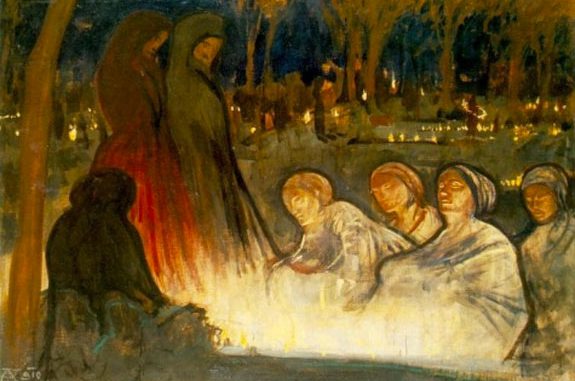

• Wis 3:1-9
• Psa 23:1-3a, 3b-4, 5, 6
• Rom 6:3-9
• Jn 6:37-40
“I’ve always had a hard time explaining purgatory,” the man said. “Didn’t the Second Vatican Council say that Catholics no longer have to believe in purgatory?”
That remark was made to me years ago, not long after I had entered the Catholic Church. Although I was saddened to hear it, it didn’t surprise me. In the course of studying various Catholic doctrines, I had learned that certain beliefs, including purgatory, were often avoided or even ignored by some Catholics. And this, unfortunately, meant that many Catholics don’t appreciate the Feast of All Souls, which is all about praying for those who are in purgatory.
“I think purgatory is rather simple to understand,” I responded. “The problem is that we often have to do away with our flawed notions of purgatory.”
Growing up in a Fundamentalist home, I had been told purgatory was the belief that everyone gets a “second chance” after death. Purgatory, I had also been taught, was just another Catholic invention without any basis in Scripture.
What I learned years later was quite different. I saw that the early Christians prayed for the dead, and that this practice was based, in part, on the actions of those Jews who had prayed for the dead (cf., 2 Macc. 12:41-46). As today’s reading from the Book of Wisdom indicates, the idea of spiritual cleansing was a common one in the Old Testament: “For if before men, indeed, they be punished, yet is their hope full of immortality; chastised a little, they shall be greatly blessed, because God tried them and found them worthy of himself. As gold in the furnace, he proved them, and as sacrificial offerings he took them to himself.”
It followed logically that if there was life after death for the just, those who were just would be cleansed fully and completely, if necessary, before entering the presence of God. This, of course, also flowed from the deepened understanding of death and resurrection given through the life, death, and Resurrection of Jesus Christ. The Savior had promised, in today’s Gospel, “that everyone who sees the Son and believes in him may have eternal life, and I shall raise him on the last day.”
But the early Christians recognized that not every disciple of Jesus is perfectly cleansed in this life from venial sins. St. Augustine explained that the Church’s prayers, the Mass, and the giving of alms provided spiritual aid to the dead. “The whole Church,” he wrote, “observes this practice which was handed down by the Fathers: that it prays for those who have died in the communion of the Body and Blood of Christ, when they are commemorated in their own place in the sacrifice itself; and the sacrifice is offered also in memory of them, on their behalf.”
It is ironic that the culture of death, which is present in so many ways, is so afraid to face death squarely and honestly. It tries to cheat and avoid death, both mocking it and cowering before it in movies, books, video games, and music. We fear death because it is so mysterious and hidden. We fear it because it seems so unjust that the vibrancy of life can end so suddenly and completely. If this world is all that exists, then death is to be feared. But it also will not be denied.
St. Paul, on the other hand, embraced death—that is, the death of Jesus Christ. “We were indeed buried with him through baptism into death,” he wrote to the Christians in Rome, “so that, just as Christ was raised from the dead by the glory of the Father, we too might live in newness of life.”
The Feast of All Souls not only provides us an opportunity to pray for those who have gone before us, but also reminds us of our mortal end. We cannot deny it. But by God’s grace we can and should prepare for it, trusting that the Lord our Shepherd will guide us through the valley of darkness.
(This “Opening the Word” column originally appeared in the November 2, 2008, edition of Our Sunday Visitor newspaper.)
If you value the news and views Catholic World Report provides, please consider donating to support our efforts. Your contribution will help us continue to make CWR available to all readers worldwide for free, without a subscription. Thank you for your generosity!
Click here for more information on donating to CWR. Click here to sign up for our newsletter.


